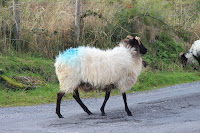Today we leave Ireland and fly to Toronto, then take the train to London, Ontario to spend Thanksgiving with dear old friends. So since we won’t be doing anything interesting to report, we thought we’d give you a few observations from our time in Ireland.
Driving:
In Canada, signs give you the appropriate speed for the road ahead. If there are dangerous curves, there’s a dangerous curve sign and a 30 kmh sign to go with it. Here, there are just maximum speed signs — it’s up to you to slow down if you think you need to.
So everything is 100 kmh or 80 kmh unless you’re going through a town, where it is 60 or 50. Usually just before a tight curve, there will be a 100 kmh sign, just to dare you to try it.
Then there’s the sign “Hidden Dip”, which encourages you to find it if you can. Why not just mark where it is? “Dip in 20 metres.” That would be helpful. “See if you can find a dip” is not.
Our satnav (GPS), Colleen sent us on some spectacularly narrow roads. Roads that would have made nice wide footpaths back home. And despite the fact that they could in no way accommodate two-way traffic, they were posted at 80 kmh. Insane!
This isn’t just a matter of foreigners complaining — the locals have been calling for a complete revamping of the signage for some time now.
Food:
The food in Ireland is wonderful. One thing that surprised and delighted us was the quality of the food in the museums and other tourist attractions. Back home, you do not expect food to taste homemade at a food counter in a tourist attraction. But we had lovely cakes and delicious tea served by cheery, chatty people everywhere we went. Even at the Gap of Dunloe, where it’s all about nature and hiking, there’s a pub and a lovely tea room with delectable baked treats.
And yogurt! The Irish yogurt is divine. I had a 7% fat rhubarb yogurt from Cork that was just amazing!
And yogurt! The Irish yogurt is divine. I had a 7% fat rhubarb yogurt from Cork that was just amazing!
Smells:
People still burn peat here, and you can buy peat briquettes everywhere. In the evening, the smell of peat burning in fireplaces is homey and nostalgic. The main peat company promises it will “create that homely feeling you can only get with the scent of burning real Irish peat.” In a gift store, I found little cardboard houses with peat inside that you can burn like incense to make your home smell like you’re still in Ireland.
Colours:
Green. I have never seen grass this green.
Front doors are brightly coloured, often with a centred doorknob.
Accommodations;
Fred did an amazing job of booking great rooms for us. They all had some fun quirks to get used to: the light switches are backwards to ours. The electrical plugs have on-off switches. The toilets make weird noises. The door latches have faces.
People:
Every Irish person we encountered was friendly and cheery. We also enjoyed the regional expressions and turns of phrase. In County Mayo we often heard “You’re all right,” which can mean, “That’s OK” or “Don’t worry about it” — or if used as a question (“Are you all right?) it means “How are you?”. Also, Irish people everywhere say “half-10” to mean 10:30, which was a little confusing at first.
Wildlife:
Sheep and cows are everywhere. We particularly enjoyed the sheep on Achill Island, though, as they were even on the roads. And the sheep are in fun colours! We saw hundreds of them with purple, blue, pink, and orange markings (we assume it’s dye used as branding).























































